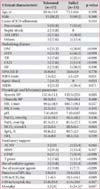1. Gardner A, Hughes D, Cook R, Henson R, Osborne S, Gardner G. Best practice in stabilisation of oral endotracheal tubes: a systematic review. Aust Crit Care. 2005; 18:158160–165.
2. Epstein SK. Endotracheal extubation. Respir Care Clin N Am. 2000; 6:321–360.
3. Betbese AJ, Perez M, Bak E, Rialp G, Mancebo J. A prospective study of unplanned endotracheal extubation in intensive care unit patients. Crit Care Med. 1998; 26:1180–1186.
4. Boulain T. Unplanned extubations in the adult intensive care unit: a prospective multicenter study. Association des Reanimateurs du Centre-Ouest. Am J Respir Crit Care Med. 1998; 157(4 Pt 1):1131–1137.
5. Christie JM, Dethlefsen M, Cane RD. Unplanned endotracheal extubation in the intensive care unit. J Clin Anesth. 1996; 8:289–293.
6. Coppolo DP, May JJ. Self-extubations: a 12-month experience. Chest. 1990; 98:165–169.
7. Thille AW, Harrois A, Schortgen F, Brun-Buisson C, Brochard L. Outcomes of extubation failure in medical intensive care unit patients. Crit Care Med. 2011; 39:2612–2618.
8. Vassal T, Anh NG, Gabillet JM, Guidet B, Staikowsky F, Offenstadt G. Prospective evaluation of self-extubations in a medical intensive care unit. Intensive Care Med. 1993; 19:340–342.
9. Epstein SK, Nevins ML, Chung J. Effect of unplanned extubation on outcome of mechanical ventilation. Am J Respir Crit Care Med. 2000; 161:1912–1916.
10. Kapadia F. Effect of unplanned extubation on outcome of mechanical ventilation. Am J Respir Crit Care Med. 2001; 163:1755–1756.
11. Lee JJ, Lee KM, Lee YB, In BM, Um DJ, Choi R. Unplanned extubation and factors affecting reintubation in ICU patients. Korean J Crit Care Med. 1996; 11:179–183.
12. Koo BN, Koh SO, Kwon TD. Predictors for reintubation after unplanned endotracheal extubation in multidisciplinary intensive care unit. Korean J Crit Care Med. 2003; 18:20–25.
13. Choi YS, Chae YR. Effects of rotated endotracheal tube fixation method on unplanned extubation, oral mucosa and facial skin integrity in ICU patients. J Korean Acad Nurs. 2012; 42:116–124.
14. Choi JH, Lee JM, Kim ES, Joo JD, Bae MS. Clinical evaluation of unplanned extubation in liver transplant patients. Korean J Anesthesiol. 1999; 37:393–397.
15. Cho YS, Yeo JH. Risk factors for deliberate self-extubation. J Korean Acad Nurs. 2014; 44:573–580.
16. Meade M, Guyatt G, Cook D, Griffith L, Sinuff T, Kergl C, et al. Predicting success in weaning from mechanical ventilation. Chest. 2001; 120:6 Suppl. 400S–424S.
17. Kiekkas P, Aretha D, Panteli E, Baltopoulos GI, Filos KS. Unplanned extubation in critically ill adults: clinical review. Nurs Crit Care. 2013; 18:123–134.
18. Epstein SK, Ciubotaru RL, Wong JB. Effect of failed extubation on the outcome of mechanical ventilation. Chest. 1997; 112:186–192.
19. Stauffer JL, Olson DE, Petty TL. Complications and consequences of endotracheal intubation and tracheotomy: a prospective study of 150 critically ill adult patients. Am J Med. 1981; 70:65–76.
20. de Lassence A, Alberti C, Azoulay E, Le Miere E, Cheval C, Vincent F, et al. Impact of unplanned extubation and reintubation after weaning on nosocomial pneumonia risk in the intensive care unit: a prospective multicenter study. Anesthesiology. 2002; 97:148–156.
21. Chen CM, Chan KS, Fong Y, Hsing SC, Cheng AC, Sung MY, et al. Age is an important predictor of failed unplanned extubation. Int J Gerontol. 2010; 4:120–129.
22. Krinsley JS, Barone JE. The drive to survive: unplanned extubation in the ICU. Chest. 2005; 128:560–566.
23. Chen CZ, Chu YC, Lee CH, Chen CW, Chang HY, Hsiue TR. Factors predicting reintubation after unplanned extubation. J Formos Med Assoc. 2002; 101:542–546.
24. Whelan J, Simpson SQ, Levy H. Unplanned extubation: predictors of successful termination of mechanical ventilatory support. Chest. 1994; 105:1808–1812.
25. Tanios M, Epstein S, Grzeskowiak M, Nguyen HM, Park H, Leo J. Influence of sedation strategies on unplanned extubation in a mixed intensive care unit. Am J Crit Care. 2014; 23:306–314.
26. Chang LY, Wang KW, Chao YF. Influence of physical restraint on unplanned extubation of adult intensive care patients: a case-control study. Am J Crit Care. 2008; 17:408–415.
27. Barnason S, Graham J, Wild MC, Jensen LB, Rasmussen D, Schulz P, et al. Comparison of two endotracheal tube securement techniques on unplanned extubation, oral mucosa, and facial skin integrity. Heart Lung. 1998; 27:409–417.
28. Murdoch E, Holdgate A. A comparison of tape-tying versus a tube-holding device for securing endotracheal tubes in adults. Anaesth Intensive Care. 2007; 35:730–735.
29. Jarachovic M, Mason M, Kerber K, McNett M. The role of standardized protocols in unplanned extubations in a medical intensive care unit. Am J Crit Care. 2011; 20:304–311.






 PDF
PDF ePub
ePub Citation
Citation Print
Print


 XML Download
XML Download